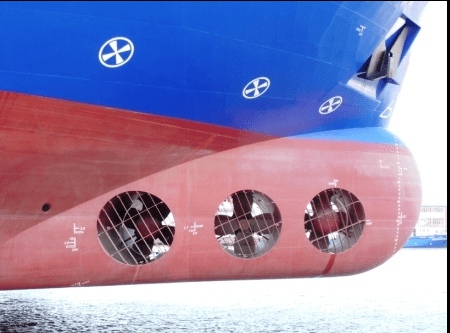Navigation
Install the app
How to install the app on iOS
Follow along with the video below to see how to install our site as a web app on your home screen.
Note: This feature may not be available in some browsers.
More options
Style variation
-
Congratulations TugboatEng on being selected by the Eng-Tips community for having the most helpful posts in the forums last week. Way to Go!
You are using an out of date browser. It may not display this or other websites correctly.
You should upgrade or use an alternative browser.
You should upgrade or use an alternative browser.
Baltimore Bridge collapse after ship collision 125
- Thread starter Tomfh
- Start date
- Status
- Not open for further replies.
Alistair_Heaton
Mechanical
i thought he was referring to a gear box type setup to the generator. But that's why I asked I don't know.
-
1
- #263
TugboatEng
Marine/Ocean
Usually there are 3 switchboards. Two mains and an emergency. These power will loads on the ships.
All switchboards are inter-connected by bus tie breakers.
Critical loads are distributed amongst the switchboards. For example, each main switchboard supplies power to an engine cooling pump. The steering gear will have one power unit on a main SWB and the other on the emergency switchboard.
The bus tie breaker to the emergency switchboard has an under voltage trip. This breaker requires a key to reset that is carried only by the chief engineer.
There are 3+ generator sets which can be paralleled.
Each generator circuit breaker has a reverse power relay to prevent motorizing.
The switchboards have automatic load shedding for non-essential loads so the ship should be able to run on a single generator set.
The main engine cannot run continuously on the emergency generator. I was mistaken earlier when I said that. The generator set is too small to power the necessary pumps.
The large amount of black smoke could have indicated the engine was still running but the power failure caused the auxiliary blowers to stop operating which may have starved the engine for air
.I have never operated a slow speed diesel, I don't know how much load is required before the turbochargers can supply sufficient charge air. I did all of my training on steam.
All switchboards are inter-connected by bus tie breakers.
Critical loads are distributed amongst the switchboards. For example, each main switchboard supplies power to an engine cooling pump. The steering gear will have one power unit on a main SWB and the other on the emergency switchboard.
The bus tie breaker to the emergency switchboard has an under voltage trip. This breaker requires a key to reset that is carried only by the chief engineer.
There are 3+ generator sets which can be paralleled.
Each generator circuit breaker has a reverse power relay to prevent motorizing.
The switchboards have automatic load shedding for non-essential loads so the ship should be able to run on a single generator set.
The main engine cannot run continuously on the emergency generator. I was mistaken earlier when I said that. The generator set is too small to power the necessary pumps.
The large amount of black smoke could have indicated the engine was still running but the power failure caused the auxiliary blowers to stop operating which may have starved the engine for air
.I have never operated a slow speed diesel, I don't know how much load is required before the turbochargers can supply sufficient charge air. I did all of my training on steam.
TugboatEng said:Usually there are 3 switchboards. Two mains and an emergency ...
Great input. alleged MV Dali drives/generators:
Dali is propelled by a single low-speed two-stroke crosshead diesel engine coupled to a fixed-pitch propeller. Her main engine, a 9-cylinder MAN-B&W 9S90ME-C9.2[9] unit manufactured by Hyundai Heavy Industries under license, is rated 41,480 kW (55,630 hp) at 82.5 rpm.[2] Her service speed is 22 knots (41 km/h; 25 mph).[5]
For maneuvering in ports, Dali has a single 3,000 kW (4,000 hp) bow thruster. Electricity is generated onboard by two 3,840 kW (5,150 hp) and two 4,400 kW (5,900 hp) auxiliary diesel generators.[4]
Kevin Kelleher, P.E. (retired)
Internal Mechanical Eng'g Consultant
DuPont ESD Specialists
Brian Malone
Industrial
Alistair, I hope my comment on DG did not appear as a dig to you. I was asking for confirmation on the DG acronym since jargon is often used but no definition provided for those, like me who are not familiar.
LittleInch
Petroleum
That looks like a fairly standard big plant switchboard system.
The devil is in the detail of what is on which board and which systems are protected with UPS and which generators are linked to which board.
The fact all the lights went out looks pretty bad because it strongly implies the emergency board went down as well. One or more of those generators is usually then designated as the emergency board feed, but it takes 10 to 15 seconds to get up to speed and stabilised before the breakers drop in and the lights come back on.
However a lot of systems won't like suddenly being deprived of power and can trip as well on restart. Also depends on how well they've maintained the UPS on the control system. Not unknown for the batteries to be dead after 10 to 15 years of doing nothing.
Remember - More details = better answers
Also: If you get a response it's polite to respond to it.
The devil is in the detail of what is on which board and which systems are protected with UPS and which generators are linked to which board.
The fact all the lights went out looks pretty bad because it strongly implies the emergency board went down as well. One or more of those generators is usually then designated as the emergency board feed, but it takes 10 to 15 seconds to get up to speed and stabilised before the breakers drop in and the lights come back on.
However a lot of systems won't like suddenly being deprived of power and can trip as well on restart. Also depends on how well they've maintained the UPS on the control system. Not unknown for the batteries to be dead after 10 to 15 years of doing nothing.
Remember - More details = better answers
Also: If you get a response it's polite to respond to it.
Alistair_Heaton
Mechanical
Far from it Brian.
I know the aviation acronyms which there are thousands of. Sometimes they use the same letters and you have to work out the subject ie aircraft system, NAV, ground handling etc
Marine we are in the same league of knowledge of them ie pretty much zero in my case.
I know the aviation acronyms which there are thousands of. Sometimes they use the same letters and you have to work out the subject ie aircraft system, NAV, ground handling etc
Marine we are in the same league of knowledge of them ie pretty much zero in my case.
FYI, for those who are interested, there is a Chinese (I know, might not be the best source, obviously download at your own risk) ship simulator/trainer that one can install and experiment with, located here:
It is free for some of the ship models, but requires registration (I used one of my throwaway email addresses).
It seems fairly comprehensive, although some of the ships simulated seem to be broken/incomplete (I've been trying for days to get the entire AC electrical system up on their "Steam Turbine Powered LNG Ship ERS," for instance. I'm at the point of suspecting that there is a bug in this one, but I could be wrong).
Anyways, they have a simulator for "ULCS (10020 TEU) ERS" that I'm assuming is SOMEWHAT (basically same size class) similar to the ship in question, although I'd expect that the exact wiring details/installed equipment would vary per individual ship.
In this simulation, the only lighting circuits on the emergency bus are some engine room emergency lights. The main lighting panel (seems to be LVMSB220V) derives it's power from a 440v normal power bus, through a 220v transformer (actually a pair for redundancy).
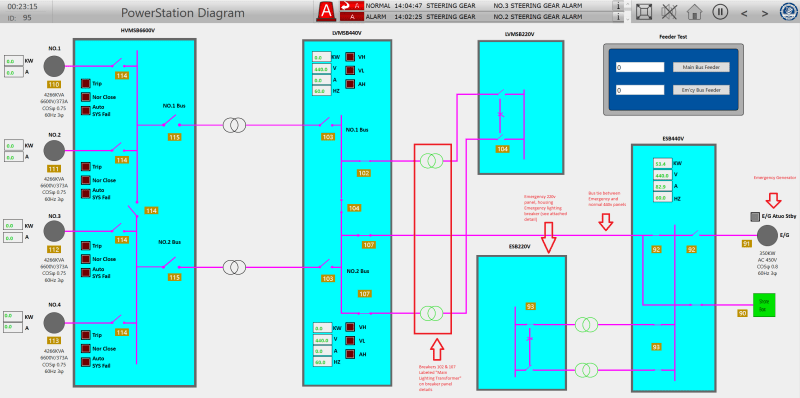
You can drill down to each panel/etc to see and control/simulate the actual breakers, so the above diagram is only a top-level view.
Detail from the 440v emergency switchboard:
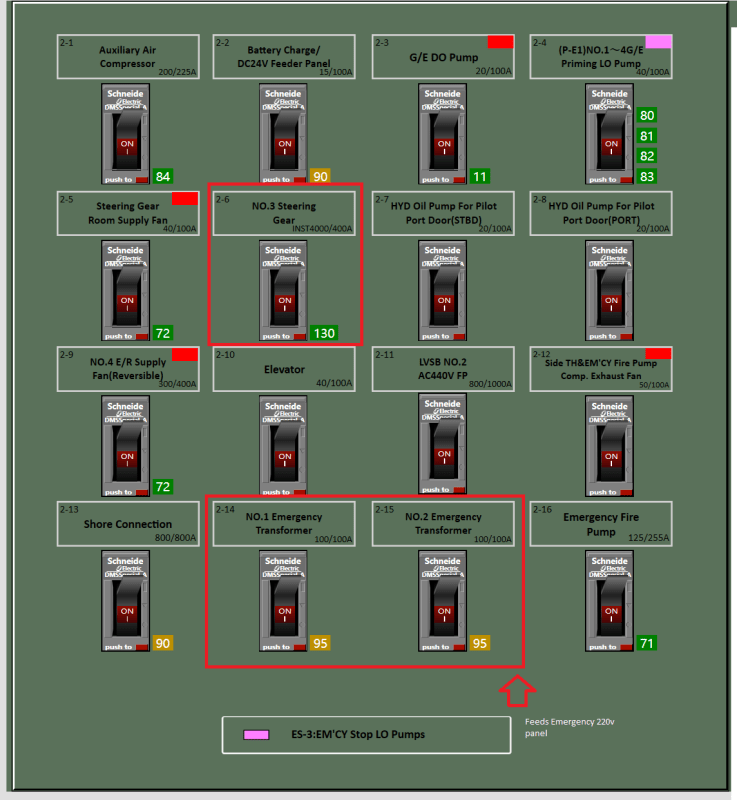
Detail from the 220v emergency switchboard:
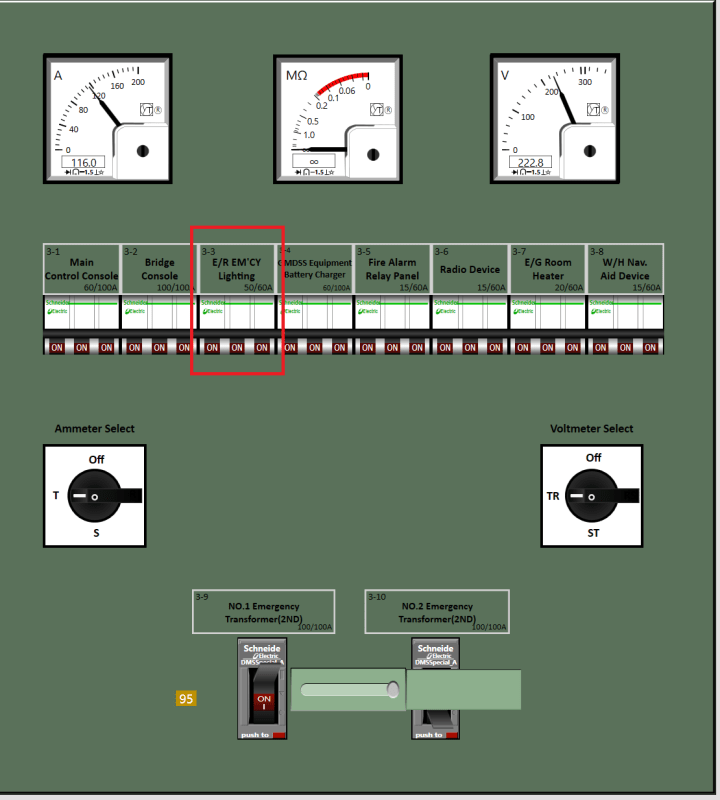
Detail of half of the Normal 440v switchboard:
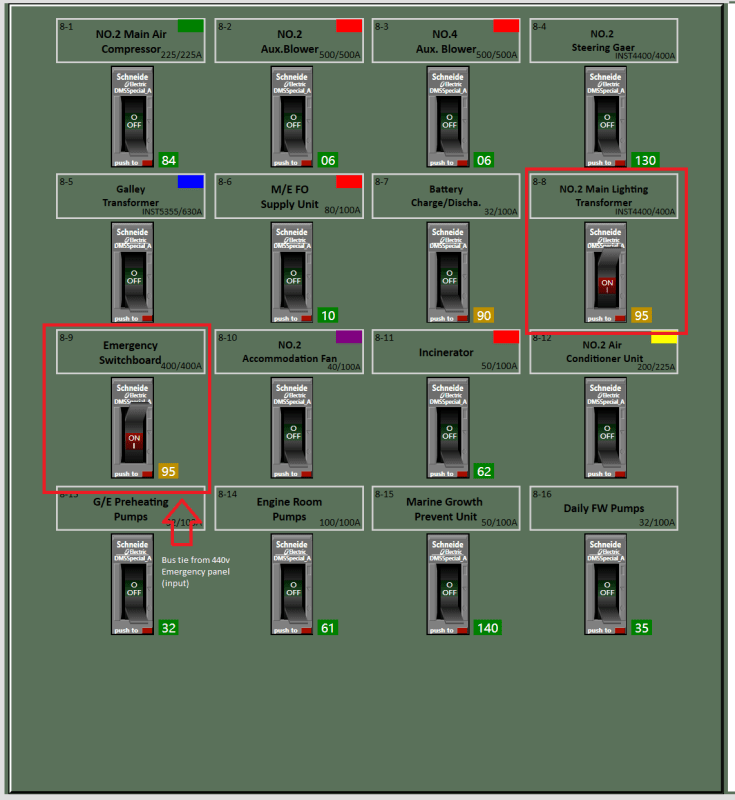
Of course, the question is, how close is this to the layout of the MV Dali?
It is free for some of the ship models, but requires registration (I used one of my throwaway email addresses).
It seems fairly comprehensive, although some of the ships simulated seem to be broken/incomplete (I've been trying for days to get the entire AC electrical system up on their "Steam Turbine Powered LNG Ship ERS," for instance. I'm at the point of suspecting that there is a bug in this one, but I could be wrong).
Anyways, they have a simulator for "ULCS (10020 TEU) ERS" that I'm assuming is SOMEWHAT (basically same size class) similar to the ship in question, although I'd expect that the exact wiring details/installed equipment would vary per individual ship.
In this simulation, the only lighting circuits on the emergency bus are some engine room emergency lights. The main lighting panel (seems to be LVMSB220V) derives it's power from a 440v normal power bus, through a 220v transformer (actually a pair for redundancy).

You can drill down to each panel/etc to see and control/simulate the actual breakers, so the above diagram is only a top-level view.
Detail from the 440v emergency switchboard:

Detail from the 220v emergency switchboard:

Detail of half of the Normal 440v switchboard:

Of course, the question is, how close is this to the layout of the MV Dali?
- Moderator
- #269
Small diesel engines,ie:trucks, diesel generators, pumps and compressors:I don't know how much load is required before the turbochargers can supply sufficient charge air. I did all of my training on steam.
Don't confuse the action of a turbo charger with the action of a two stroke scavenging blower.
The engines act as NA, Naturally Aspirated at idle. As load is applied, the turbo spins up.
Modern diesel engines limit the fuel charge when accelerating so as to avoid overfueling and black smoke until the turbo spins up. Early engines used a mechanical aneroid valve which could easily be defeated.
The result was a cloud of black smoke until the turbo had spooled up and was supplying enough air for the fueling rate.
--------------------
Ohm's law
Not just a good idea;
It's the LAW!
TugboatEng
Marine/Ocean
Modern slow speed diesel have electric blowers for scavenging during starting and light load operation.
Remember, these are 2-stroke engines. They don't have intake or exhaust strokes so they require an air pump. That might be the underside of the piston and reed valves (Sulzer RND) or electric blowers.
Remember, these are 2-stroke engines. They don't have intake or exhaust strokes so they require an air pump. That might be the underside of the piston and reed valves (Sulzer RND) or electric blowers.
-
1
- #271
Re: Musk Engineer Discussion.
To me, the ultimate mark of someone who is deploying engineering expertise is the ability to generate a successful outcome.
While generating a successful outcome in the technical realm depends on being able to deploy useful technical hard skills (engineering), it also requires the synthesis of many others soft ones (project execution, finance, leadership, decision making, etc.). I award almost no points to those who beat their chest trumpeting their hard skills yet are unable to harness the all forces needed generate a successful outcome. Why build a ship if it cannot harness the wind?
Take the Roeblings. Engineers, right? Do you think the Brooklyn Bridge would have gotten built if they couldn't have also manufactured the cables themselves? What came first, the ability to create a company that manufactured wire or the ability to engineer designs that utilized it?
On Plant Earth, there is no one else that I'm aware of that has been able to generate as many successful engineering-related outcomes as Musk. Yes, there are legions of engineers, managers, financiers, and the like in the trenches at the organizations he is a part of that carry 99% of the load toward those successes. But I'd say that there is a 99% chance that Earth wouldn't have independently generated those companies and outcomes without him.
He's aware, curious, intelligent, ethical, filled with useful hard and soft skills, and is best in class in generating successful outcomes. If that's not the formula for engineering expertise, then what is?
To me, the ultimate mark of someone who is deploying engineering expertise is the ability to generate a successful outcome.
While generating a successful outcome in the technical realm depends on being able to deploy useful technical hard skills (engineering), it also requires the synthesis of many others soft ones (project execution, finance, leadership, decision making, etc.). I award almost no points to those who beat their chest trumpeting their hard skills yet are unable to harness the all forces needed generate a successful outcome. Why build a ship if it cannot harness the wind?
Take the Roeblings. Engineers, right? Do you think the Brooklyn Bridge would have gotten built if they couldn't have also manufactured the cables themselves? What came first, the ability to create a company that manufactured wire or the ability to engineer designs that utilized it?
On Plant Earth, there is no one else that I'm aware of that has been able to generate as many successful engineering-related outcomes as Musk. Yes, there are legions of engineers, managers, financiers, and the like in the trenches at the organizations he is a part of that carry 99% of the load toward those successes. But I'd say that there is a 99% chance that Earth wouldn't have independently generated those companies and outcomes without him.
He's aware, curious, intelligent, ethical, filled with useful hard and soft skills, and is best in class in generating successful outcomes. If that's not the formula for engineering expertise, then what is?
Re: 2020s Baltimore Cleanup vs. Potential 1940s NYC Cleanup.
How does our ability to cleanup a bridge collapse in a harbor compare now to the 1930s/1940s?
I recall one of the reasons why Robert Moses' Brooklyn Battery Bridge was shot down in favor of a tunnel was the risk of a collapse blocking the Brooklyn Naval Yard. (And of course his feud with Roosevelt and the destruction of Battery Park for a bridge, etc.)
As I'm watching Baltimore work to clear a channel in a matter of weeks, I'm just curious how long it would have taken for NYC to clear a potential WWII-era collapse of a Brooklyn-Battery Bridge (if it was built and then attacked).
Does anyone in the Marine Engineering space have a feel for that?
How does our ability to cleanup a bridge collapse in a harbor compare now to the 1930s/1940s?
I recall one of the reasons why Robert Moses' Brooklyn Battery Bridge was shot down in favor of a tunnel was the risk of a collapse blocking the Brooklyn Naval Yard. (And of course his feud with Roosevelt and the destruction of Battery Park for a bridge, etc.)
As I'm watching Baltimore work to clear a channel in a matter of weeks, I'm just curious how long it would have taken for NYC to clear a potential WWII-era collapse of a Brooklyn-Battery Bridge (if it was built and then attacked).
Does anyone in the Marine Engineering space have a feel for that?
-
2
- #274
Murph 9000
Computer
It's not conclusive, as he's not got significant evidence beyond what we already have here, but he's very qualified to talk about it and give his interpretation of what we know:
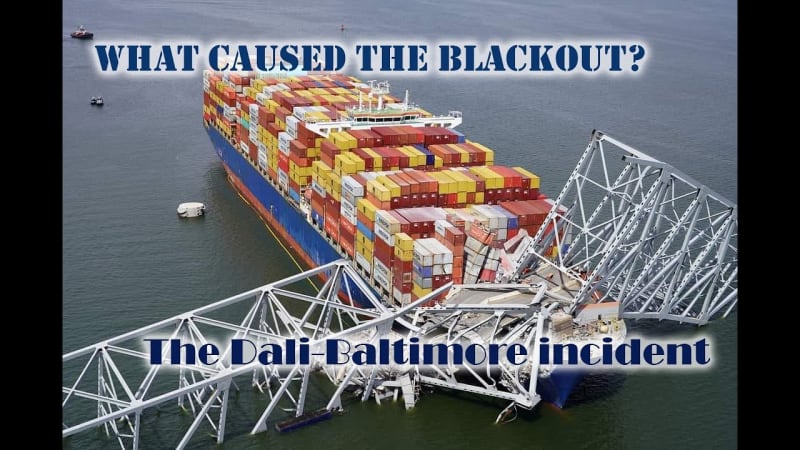
Chief MAKOi - What caused the Power Failure : The Dali Incident

Chief MAKOi - What caused the Power Failure : The Dali Incident
- Moderator
- #275
I haven't seen any speculation concerning the bow thruster.Wiki said:For maneuvering in ports, Dali has a single 3,000 kW (4,000 hp) bow thruster. Electricity is generated onboard by two 3,840 kW (5,150 hp) and two 4,400 kW (5,900 hp) auxiliary diesel generators.
A motor failing by turn to turn shorts may still pass a megger test.
It will, however, quickly progress to total failure.
There is speculation concerning the relative ineffectiveness of the rudder without propulsion.
A progressively failing phase in the thruster motor could easily make one or possibly two of those auxiliaries "Roll Coal".
--------------------
Ohm's law
Not just a good idea;
It's the LAW!
Interesting youtube...
-----*****-----
So strange to see the singularity approaching while the entire planet is rapidly turning into a hellscape. -John Coates
-Dik
-----*****-----
So strange to see the singularity approaching while the entire planet is rapidly turning into a hellscape. -John Coates
-Dik
Just as important as the discussion about ensure ships operate safely in the confined space of a port, is the important issue of protecting bridges.
The requirements for the design of bridge pier protection exist - AASHTO Guide Specification and Commentary for Vessel Collision Design of Highway Bridges.
Sorry I do not have access to a free copy. This next document is an explanation of a program FDOT created to implement the calculations in the preceding document.
Basics of Vessel Collision; Stephen Fowler, PE and Matthew Kosar, PE
What does not seem to exist is a mandate to retrofit critical bridges.
Why the Chesapeake Bay Bridge is just as Vulnerable to Collapse from Ship Impacts as the Key Bridge; Casey Jones -
The requirements for the design of bridge pier protection exist - AASHTO Guide Specification and Commentary for Vessel Collision Design of Highway Bridges.
Sorry I do not have access to a free copy. This next document is an explanation of a program FDOT created to implement the calculations in the preceding document.
Basics of Vessel Collision; Stephen Fowler, PE and Matthew Kosar, PE
What does not seem to exist is a mandate to retrofit critical bridges.
Why the Chesapeake Bay Bridge is just as Vulnerable to Collapse from Ship Impacts as the Key Bridge; Casey Jones -
- Moderator
- #279
Admitted the efficiency will be much less when underway, but when the rudder is ineffective, ant help from the bow thruster may help turn the ship.Can't imagine the bow thrusters were still running by the time the ship was established in the channel and making 8 kt - or that they'd have that much effect even if they were.
And a failing thruster could explain both the lack of turning effort and the black smoke. (rolling coal in red-neck speak)
--------------------
Ohm's law
Not just a good idea;
It's the LAW!
- Moderator
- #280
- Status
- Not open for further replies.
Similar threads
- Replies
- 0
- Views
- 685
- Replies
- 13
- Views
- 13K
- Question
- Replies
- 39
- Views
- 21K
- Replies
- 17
- Views
- 11K
- Replies
- 25
- Views
- 25K

